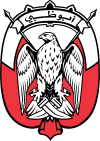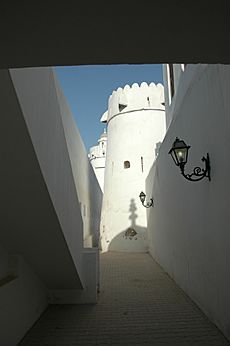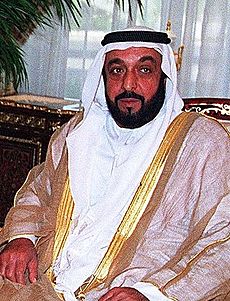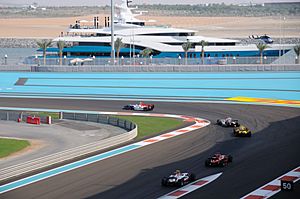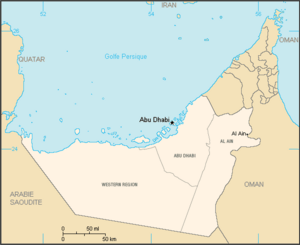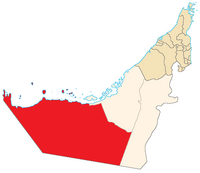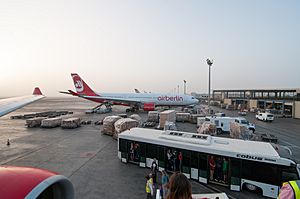Emirate of Abu Dhabi facts for kids
Quick facts for kids
Emirate of Abu Dhabi
إِمَـارَة أَبُـوظَـبِي
|
|||
|---|---|---|---|
|
Emirate
|
|||
|
|||
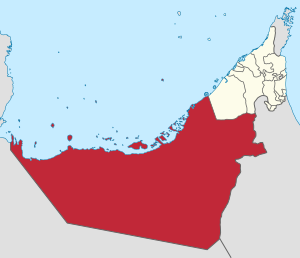
Location of Abu Dhabi in the UAE
|
|||
| Country | |||
| Independence from the UK | 2 December 1971 | ||
| Seat | Abu Dhabi | ||
| Subdivisions |
3 Municipal Regions
Abu Dhabi (Central Region)
Al-Ain (Eastern Region) Adh-Dhafrah (Western Region) |
||
| Government | |||
| • Type | Islamic absolute monarchy within a federation | ||
| Area | |||
| • Total | 67,340 km2 (26,000 sq mi) | ||
| Area rank | 1st | ||
| Population | |||
| • Total | 2,784,490 | ||
| • Rank | 2nd | ||
| • Density | 35.7/km2 (92/sq mi) | ||
| Demonym(s) | Abu Dhabian | ||
| Time zone | UTC+4 (UAE standard time) | ||
| • Summer (DST) | UTC+4 | ||
| ISO 3166 code | AE-AZ | ||
| GDP (Nominal, 2021 estimate) | AED 840.513 billion (US$229 billion) | ||
The Emirate of Abu Dhabi is one of the seven emirates that make up the United Arab Emirates (UAE). It is the largest emirate, covering about 87% of the country's total land area. This means it covers 67,340 square kilometers (26,000 sq mi).
Abu Dhabi also has the second-largest population among the seven emirates. In 2011, about 2.1 million people lived there. Less than 21% of these people were Emirati citizens. The city of Abu Dhabi is the capital of both the emirate and the entire UAE.
In the early 1970s, two big changes happened for Abu Dhabi. First, the United Arab Emirates was formed in December 1971. Abu Dhabi became its main political and administrative capital. Second, oil prices went up a lot after the Yom Kippur War. This led to a huge increase in money from oil. In 2014, Abu Dhabi's economy (called Gross Domestic Product or GDP) was about 960 billion UAE Dirhams (AED), which is like 0.24 trillion Euros. Most of this money (58.5% in 2011) came from mining and quarrying, which includes crude oil and natural gas. Building industries were the next biggest part of the economy.
Contents
What Does "Abu Dhabi" Mean?
Before it was called Abu Dhabi, this area was known as Milh. In Arabic, Milh means salt. This name likely came from the salt water found in the area. Today, Milh is still the name of one of Abu Dhabi's islands.
"Dhabi" is the Arabic name for a type of gazelle that used to be common here. So, Abu Dhabi means "father of Dhabi" (gazelle). People have used this name for over 300 years. The story of how the name came about has been passed down through poems and legends. It is believed the name came from the many gazelles in the area. There is also a popular folk tale about Sheikh Shakhbut bin Dhiyab al Nahyan and the founding of Abu Dhabi city.
A Look Back: History of Abu Dhabi
People have lived in parts of Abu Dhabi for thousands of years. Its early history involved nomadic herding and fishing. The emirate shares a historical area called Al-Buraimi or Tawam (which includes modern-day Al Ain) with Oman. Evidence shows people lived there for over 7000 years.
Modern Abu Dhabi's story begins with the rise of a powerful group of tribes called the Bani Yas. This happened in the late 1700s. They also took control of Dubai. Later, in the 1800s, the Dubai and Abu Dhabi parts of the Bani Yas went their separate ways.
Until the mid-1900s, Abu Dhabi's economy relied mostly on camel herding. People also grew dates and vegetables in the inland oases of Al-Ain and Liwa. Fishing and pearl diving were important along the coast of Abu Dhabi city. Most homes in Abu Dhabi city were made from palm fronds (called barasti). Richer families lived in mud huts. When the cultured pearl industry grew in the early 1900s, it caused problems for Abu Dhabi. Pearls were their biggest export and main source of money.
In 1939, Sheikh Shakhbut Bin-Sultan Al Nahyan allowed companies to search for oil. Oil was first found in 1958. At first, the oil money did not change much. A few concrete buildings were built, and the first paved road was finished in 1961. But Sheikh Shakbut was careful. He was not sure if the oil money would last, so he saved it instead of spending it on development.
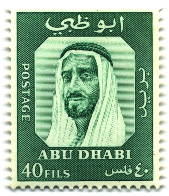
His brother, Sheikh Zayed bin Sultan Al Nahyan, saw that oil wealth could completely change Abu Dhabi. The ruling Nahyan family decided that Sheikh Zayed should become the new ruler. He would carry out his plan to develop the country. On August 6, 1966, with help from the British, Zayed became the new ruler.
In 1968, the UK announced it would leave the Persian Gulf area by 1971. Sheikh Zayed then became the main person pushing for the formation of the UAE. After the Emirates became independent in 1971, oil money kept flowing in. Old mud-brick huts were quickly replaced with banks, shops, and modern tall buildings.
Where is Abu Dhabi? Geography and Climate
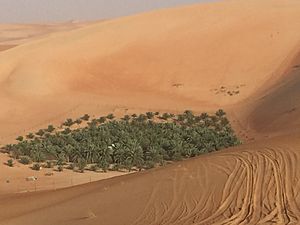
The United Arab Emirates is in the oil-rich Arabian or Persian Gulf region. It is next to Saudi Arabia and the Sultanate of Oman.
Abu Dhabi is in the far west and southwest of the United Arab Emirates. It lies along the southern coast of the Persian Gulf. It shares borders with the emirate of Dubai and the emirate of Sharjah to its north.
The total area of the Emirate is about 67,340 square kilometers. This is about 87% of the UAE's total area, not counting islands. The waters of the Emirate have about 200 islands along its 700 km (430 mi) coastline. The land is mostly low and sandy, with sand dunes that can be over 300 meters (980 ft) high in the south. The eastern part of the Emirate is near the western edge of the Hajar Mountains. Hafeet Mountain, Abu Dhabi's highest point, is south of Al-Ain City. It rises between 1,100 and 1,400 meters (3,600-4,600 ft).
Over the last ten years, farming and planting trees have made "green" areas bigger. About 5% of the land is now green, including parks and roadside plants. About 1.2% of the land is used for farming. A small part of the land has mountains with caves. The coastal area has wetlands and mangrove forests. Abu Dhabi also has many islands. Most are small and empty, but some are protected areas for wildlife.
What is the Weather Like?
The emirate is in a tropical dry area. The Tropic of Cancer line goes through the southern part of the Emirate. This means the climate is very dry. It has high temperatures all year, and summers are extremely hot. In summer (June to August), the high temperatures come with high humidity, especially near the coast. Abu Dhabi has warm winters, but sometimes it gets cool. Temperatures change between the coast, the desert, and higher areas.
Abu Dhabi does not get much rain, and the amount changes a lot each year. Winds from the north blow across the country. They help make the weather better when they don't carry dust. There are also short, moist winds from the southeast. Winds often change direction. Another thing about Abu Dhabi's weather is that water evaporates very quickly. This is because of high temperatures, wind speed, and low rainfall.
The oasis city of Al Ain is about 150 km (93 mi) away, near Oman. It often has the highest summer temperatures in the country. However, the dry desert air and cooler evenings make it a popular place to escape the intense summer heat and humidity of the capital city.
How Abu Dhabi is Governed
Abu Dhabi is ruled by an absolute, hereditary monarchy. This means the ruler's power is complete and passed down through the family. The laws are mostly based on sharia (Islamic law). Until 2022, the head of state was HH Sheikh Khalifa bin Zayed Al Nahyan. He was the son of Sheikh Zayed bin Sultan Al Nahyan, who was the first president of the United Arab Emirates. The Qasr al-Hosn was the palace and government seat for Abu Dhabi's rulers from around 1760/1790 until 1966.
Emir Mohamed bin Zayed Al Nahyan (who used to be the crown prince) has a lot of power. He leads the Executive Council and is the deputy supreme commander of the UAE's armed forces. The Executive Council is the government of the emirate. The crown prince gets help from the Crown Prince's Court. The Executive Council now has 98 members. Many are important members of the ruling family, along with respected politicians.
Below the Executive Council are different departments that act like ministries. Examples include the Education Council and the Urban Planning Council. There are also independent groups like the environmental agency and the Abu Dhabi Tourism Authority. The Abu Dhabi Police is the main group that enforces laws.
At the national level, all emirates have their hereditary rulers. These rulers together form the Federal Supreme Council of Rulers, led by the president. The presidency is voted on every five years, but it is generally understood that Abu Dhabi's ruler will always be chosen as president.
Even though there is no elected parliament, there is a traditional meeting called the majlis. This is a way for people to share their thoughts and take part in politics. The emir and royal family members hold an open meeting where any citizen can come and speak about their concerns.
At the local level, each area has its own government. These are under the Department of Municipal Affairs. Examples include the Abu Dhabi capital district and the Western and Eastern Region Municipalities. The government gets most of its money from selling oil. Any extra money is managed by the Abu Dhabi Investment Authority. This group invests the money into different government projects.
People of Abu Dhabi
| Historical population | ||
|---|---|---|
| Year | Pop. | ±% p.a. |
| 1980 | 451,848 | — |
| 1985 | 566,036 | +4.61% |
| 1995 | 942,463 | +5.23% |
| 2005 | 1,399,484 | +4.03% |
| 2010 | 1,967,659 | +7.05% |
| 2015 | 2,784,490 | +7.19% |
| Source: Citypopulation | ||
The number of people living in Abu Dhabi has grown a lot in the last 50 years. This huge increase has made the size, makeup, and spread of the population very important for future plans.
In mid-2010, Abu Dhabi's population reached 1.968 million. It grew by 9.6% each year since 1960, which is one of the highest rates in the world. The total population grew 99 times in 50 years. The number of citizens grew 39 times, and non-citizens grew 173 times between 1960 and 2010. The main reason for the growth in citizens is new people becoming citizens. For the overall population, the main reason is people moving to Abu Dhabi from other countries.
In 2011, over 2 million people lived in the Abu Dhabi Emirate. In mid-2011, about 1.31 million people lived in the Abu Dhabi Region. About 0.58 million lived in the Al Ain Region. And about 0.23 million lived in Al Gharbia. This made the total population for the Abu Dhabi Emirate 2.12 million.
In Abu Dhabi, more babies are born than in most developed parts of the world. Also, very few people die. In 2011, for citizens, there were 15.1 births for every 1,000 people. There were only 1.4 deaths for every 1,000 people.
Abu Dhabi's Economy
Abu Dhabi's economy (GDP) was estimated to be 806,031 million AED in 2011. This was a big increase from 620,316 million AED in 2010. This means the economy grew by 29.9% in 2011. The average income per person was 380.1 thousand AED in 2011. Most of the economic growth in 2011 came from "Mining and quarrying" (oil and natural gas), "Financial and insurance" services, and "Manufacturing." These areas grew by 9.4%, 10.5%, and 9.8% respectively.
Goods imported through Abu Dhabi's ports were worth 116.4 billion AED in 2011. This was up from 86.6 billion AED in 2010. The main imports in 2011 were machinery and metals. These made up 50.7% of all imports. The United States of America was the top country for imports. Abu Dhabi received 13.4 billion AED worth of goods from the US. Non-oil exports were worth 11.5 billion AED. Transport equipment and metals made up 61.5% of these exports. Canada was the main place for Abu Dhabi's non-oil exports, receiving 2.6 billion AED worth of goods in 2011. Mina' Zayid is Abu Dhabi's main port for goods.
Al-Ain has one of the few traditional camel souqs (markets) left in the country. It is near an IKEA store.
The Emirate exported 747.2 million barrels of crude oil in 2010. Japan was the top buyer, getting about 35.6% of Abu Dhabi's total crude oil exports. In 2011, the Emirate exported 10.0 million metric tons of refined oil products. The Netherlands bought 16.9% of these, and Japan bought 13.9%. The Habshan–Fujairah oil pipeline is one of the main oil pipelines. Abu Dhabi's exports of natural gas (LNG) grew by 2,973.0 million AED in 2011 compared to 2010. They reached 17,128.2 million AED. Japan bought most of the LNG exports (98.4%), followed by India (1.0%) in 2011. The Emirate imported 828,093.9 million cubic feet of natural gas in 2011. This was an average of 2,268.8 million cubic feet per day.
The National Bank of Abu Dhabi (NBAD) is the biggest bank in the emirate. It is the second-largest bank in the UAE. NBAD has the highest value among UAE banks. The government has worked to make its economy more diverse. It invests in other areas like services and tourism. The capital city has seen many new building projects and shopping malls. The Emirates Palace hotel opened as the most expensive hotel ever built. The yearly Abu Dhabi Grand Prix is a Formula One car race held in the capital city. This race brings in more tourists. Besides the capital city, the Abu Dhabi Desert Challenge is held in the countryside. The tourism board is trying to show off other places in the emirate too.
The Emirate also supports big international film productions. This helps create jobs and boosts the economy. A 2019 report said that the Film Commission gives "30% cashback on production and post-production spend in the Emirate." Because of this, film crews have shot many scenes in Abu Dhabi and nearby areas. These include Mission: Impossible – Fallout, War Machine, and 6 Underground in 2018. For 6 Underground, the UAE military helped the crew. They provided soldiers as extras and aircraft for the film. The production designer, Jeffrey Beecroft, said: "I’ve shot a lot of military stuff with Michael, but I never had the ability to have six Apache [helicopters], 10 Black Hawks and soldiers".
Areas and Cities in Abu Dhabi
The Emirate is divided into three main municipal regions. The capital city, Abu Dhabi, has many new modern tall buildings, offices, apartments, and busy shops. Other important cities in the emirate are Al-Ain, Baniyas, and Ruwais. Al-Ain is a group of villages around a desert oasis. Today, it is home to the national university, UAEU. Al-Ain is also known as the "Garden City" of the UAE.
| Region | Map | Settlements |
|---|---|---|
| Abu Dhabi Central Capital District Abu Dhabi Metropolitan Area Abu Dhabi Region |
|
|
| Al Dhafra Region Western (Gharbiyyah) Region |
|
|
| Al-Ain Region Eastern (Sharqiyyah) Region |
|
- Al Ajban
- Al Tawelah
- Al Shalelah
- Al Shamkha
- Al Wahda
- Al Mu'azaz
- Al Ad'la
- Marabe al Dhafra
Getting Around: Transport in Abu Dhabi
Abu Dhabi has two main airports: Abu Dhabi International Airport (AUH) and Al Ain International Airport (AAN). The older AUH airport used to be at Al Bateen Airport. The local time is GMT + 4 hours. Most people get around the city using private cars, rideshares, and taxis. Public buses, run by the Abu Dhabi Municipality, are also available. These are mostly used by people with lower incomes. There are bus routes to nearby towns like Baniyas, Habashan, and Al-Ain. A newer bus service started in 2005 between Abu Dhabi and the city of Dubai (about 150 km or 93 mi away). The government is also planning to build a railway in Abu Dhabi.
There are many ports in Abu Dhabi. Khalifa Port is the newest one.
Learning and Education
All private and public schools in the emirate are managed by the Abu Dhabi Education Council. Other emirates still work under the Federal Ministry of Education.
Here are some schools and universities in Abu Dhabi:
- AAESS
- Sheikh Khalifa Bin Zayed Arab Pakistani School
- Pakistan Community Welfare School
- Abu Dhabi Indian School
- Abu Dhabi Indian School Branch 1, Al Wathba
- Abu Dhabi International School
- Abu Dhabi Men's College (part of The Higher Colleges of Technology)
- Abu Dhabi University
- Abu Dhabi Women's College (part of The Higher Colleges of Technology)
- Al Bateen Secondary School (British Curriculum)
- The American Community School of Abu Dhabi
- The American International School in Abu Dhabi
- Bright Kids Nursery, Muroor Street
- Emirates College for Advanced Education (ECAE)
- Emirates Future International Academy
- INSEAD Centre in Abu Dhabi
- International School of Choueifat, Abu Dhabi
- Islamia English School
- Jarn Yafoor Middle School
- Khalifa University of Science, Technology and Research (KUSTAR)
- Masdar Institute of Science and Technology (a research university for graduate students)
- Merryland International, Musaffah
- New York Institute of Technology
- New York University Abu Dhabi
- Paris-Sorbonne University Abu Dhabi
- Shaikh Khalifa Bin Zayed Bangladesh Islamia School
- Sherwood Academy CBSE
- Sherwood Academy IGCSC
- The British School
- The Petroleum Institute
- Zayed University
- Abu Dhabi Grammar School (Canada)
- Al Mushrif
- Al Nahda National Schools (Boys' and Girls' school)
- Al Yasmina School
- Al-Noor Indian Islamic School
- Al Manhal International Private School
- Al Ma'ali International School
- Ashbal Al Quds Private School
- Emirates National School
- First Steps School Nursery
- GEMS American Academy
- Indian Islahi Islamic School
- International Community School
- Khawarizmi International College
- Our Own English High School
- St.Joseph's School
- Strathclyde Business School (MSc/MBA)
- The British School – Al Khubairat
- The Cambridge High School
- The Elite Private School
- The Glenelg School of Abu Dhabi
- The Philippine School, Abu Dhabi
See also
 In Spanish: Emirato de Abu Dabi para niños
In Spanish: Emirato de Abu Dabi para niños
- Mussafah Bridge
- Mussafah Port
- Postage stamps of Abu Dhabi
- Water supply and sanitation in Abu Dhabi
- Wildlife of the United Arab Emirates



